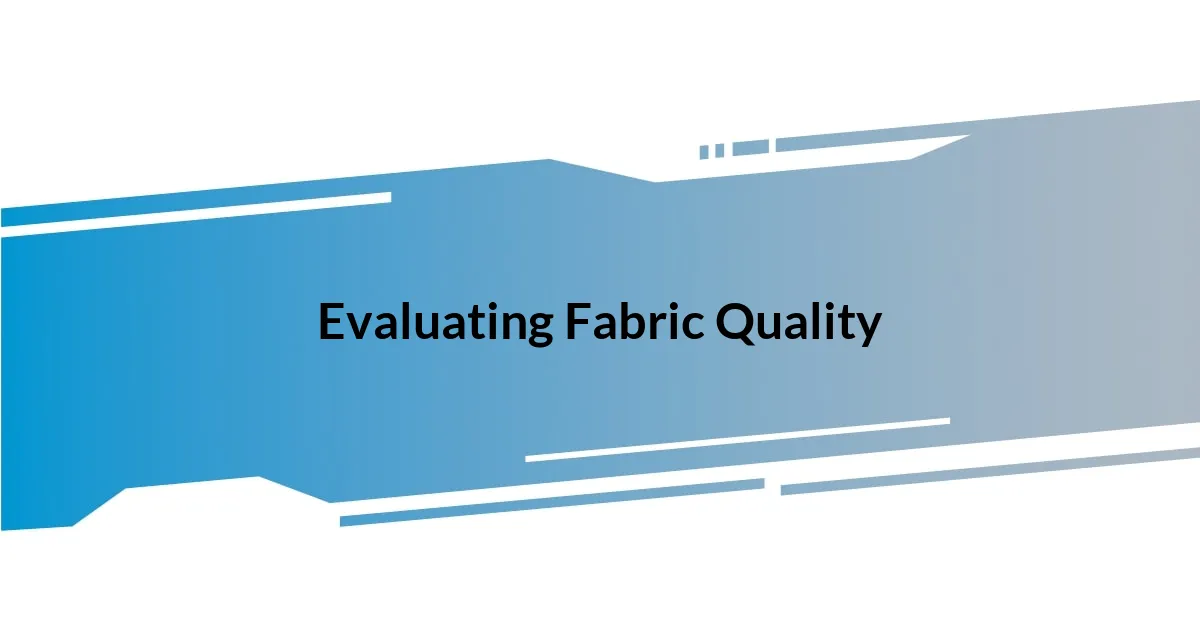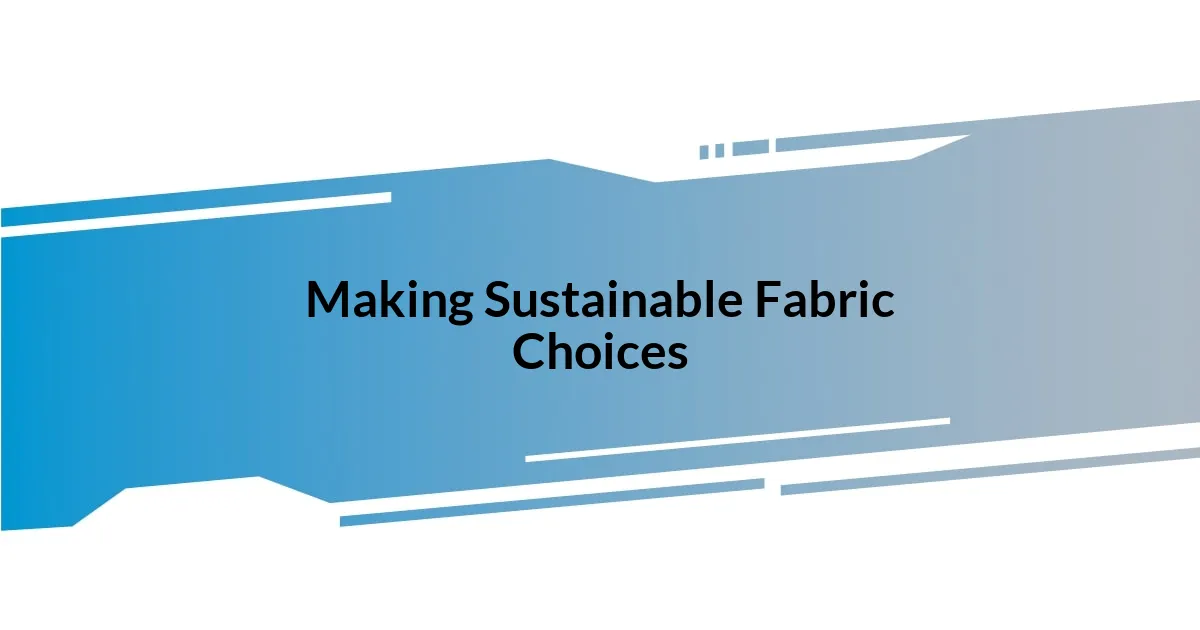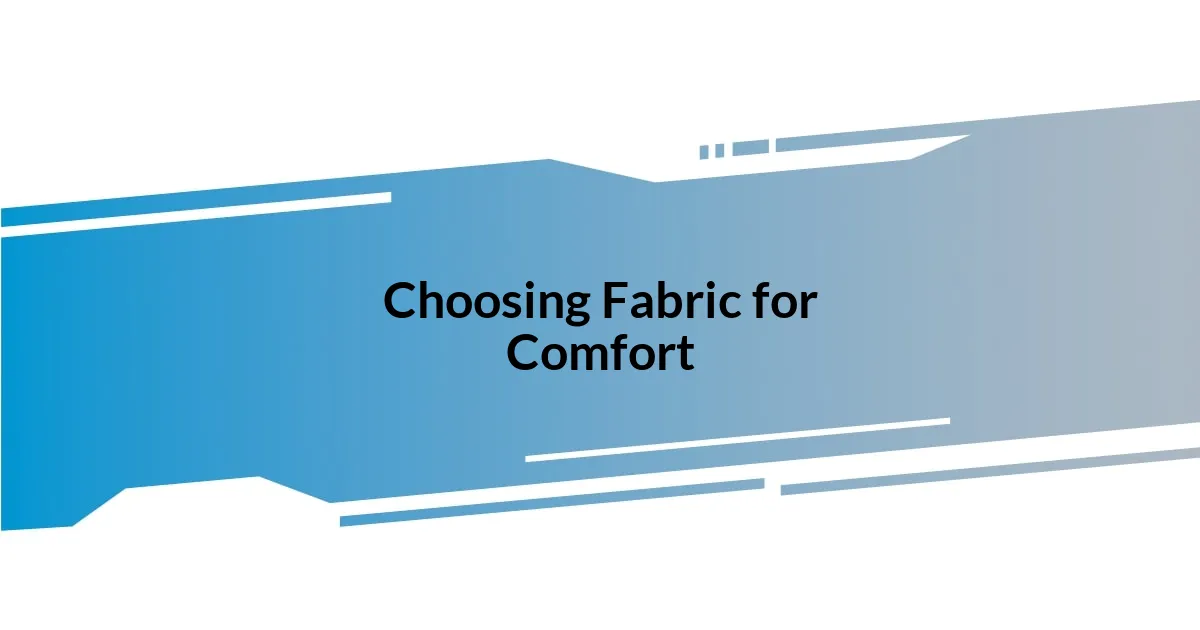Key takeaways:
- Understanding various fabric types, their properties, and how they behave is crucial for making informed wardrobe choices.
- Evaluating fabric quality involves considering weight, weave, and comfort against the skin, which impacts durability and overall satisfaction.
- Fabric care is essential; knowing washing, drying, and ironing requirements can save time and enhance enjoyment of clothing.
- Choosing fabrics sustainably and considering their lifecycle fosters an appreciation for eco-friendly practices in fashion.

Understanding Fabric Types
When I first started exploring fabric types, I was overwhelmed by the sheer variety available. Cotton, for example, is a staple that many people love for its breathability, but have you ever thought about how it shrinks in the wash? I recall the moment I pulled my favorite cotton shirt out of the dryer, only to find it had transformed into something unwearable. That’s when I learned the importance of understanding how different fabrics behave.
Synthetics like polyester intrigued me as they offer durability and resistance to wrinkles. I remember attending a fashion workshop where the instructor emphasized how these materials can retain their shape, which is especially valuable for everyday wear. It made me realize that choosing the right fabric can dramatically impact not only the garment’s lifespan but also my comfort throughout the day.
Now, let’s not forget the touch and feel of fabrics like silk or wool. The first time I slid my hands over silk, I was instantly captivated by its smoothness. Can you recall a fabric that made you feel luxurious? For me, it was a revelation that fabric choice can evoke emotions and enhance our personal style. Understanding the properties of each fabric is not just about aesthetics; it’s about how they resonate with our bodies and emotions too.

Evaluating Fabric Quality
When evaluating fabric quality, I often start by considering the weight and thickness. Heavier fabrics typically suggest durability, while lighter ones can indicate breathability. I remember purchasing a linen dress that felt airy and perfect for summer but quickly discovered it wrinkled like a roadmap. The lesson? Sometimes, a fabric’s texture can lead to unexpected maintenance challenges.
Another essential factor I look at is the weave of the fabric. A tighter weave usually results in greater strength and longevity. For instance, I once mistakenly opted for a loosely woven cotton that seemed soft to the touch but endured pilling after a few washes. It taught me that while a fabric may look appealing, its construction often tells a different story regarding how it will wear over time.
Lastly, I examine how the fabric interacts with the skin. For example, I had a cashmere sweater that felt heavenly at first, but after a few hours, it started to itch. This personal experience highlighted that a fabric’s quality is not just about how it looks but how it feels when worn. Comfort is paramount, and no one wants to compromise their well-being for style.
| Fabric Type | Quality Indicators |
|---|---|
| Wool | Softness, resilience, and warmth |
| Silk | Luster, smoothness, and drape |
| Cotton | Breathability and weight |
| Polyester | Durability and wrinkle-resistance |

Considering Fabric Care
When I think about fabric care, it’s crucial to consider how each material requires specific maintenance to keep it looking its best. I remember the time I splurged on a beautiful silk blouse, only to realize later that it needed to be dry-cleaned. The thought of regularly spending money on cleaning felt heavy, and it made me reconsider my choices. Understanding the maintenance needs of fabrics can save not just time but also frustration.
To help in assessing fabric care requirements, here’s a quick list of what I consider:
- Washing Instructions: Some fabrics like polyester can be machine-washed, while delicate items like lace may need gentle hand washing or dry cleaning.
- Drying Method: Fabrics such as wool are best laid flat to dry to prevent stretching; others like cotton can handle tumble drying but might still shrink.
- Ironing Needs: Synthetics typically resist wrinkling, while cotton and linen often need a good press to look sharp.
- Stain Resistance: Some fabrics, like treated cotton blends, can repel stains better, which adds to their allure for everyday wear.
I’ve learned that a little foresight goes a long way. Thinking about how much care a fabric will need can ultimately influence not just my wardrobe choices, but also enhance my overall enjoyment of each piece!

Testing Fabric Durability
Testing the durability of fabrics is something I take seriously, as it’s crucial for long-lasting pieces in my wardrobe. I recall a time when I decided to test a new denim fabric by wearing my favorite jeans for a whole week, doing everything from lounging at home to attending a backyard barbecue. By the end of that week, the jeans held their shape beautifully, and I felt like they could withstand any adventure I threw at them. It really brought home the importance of putting fabric through its paces.
I also enjoy performing the classic rub test to see how well a fabric can endure friction. I once bought a vibrant cotton blend for a dress because it looked stunning on the rack. After a few vigorous rubs from my fingers, I noticed some color fading. It raised a crucial question in my mind: Will I be disappointed every time I wear a fabric that can’t handle the wear and tear of regular use? That dress quickly became a reminder that not all eye-catching fabrics are built to last.
Another effective method I’ve tried is the stretching test. Fabrics that spring back into shape after a little pull typically indicate better durability. I’ll never forget when I bought a stretchy knit fabric for a top—after a few wears, I found it sagging, which left me feeling frustrated. Did I really waste my time and money on a piece that didn’t hold up? The lesson is clear: testing fabric durability isn’t just about the fabric’s initial appeal; it’s about understanding how it will serve me in the long run.

Making Sustainable Fabric Choices
Making sustainable fabric choices is something I think about more these days. I remember when I bought a dress made from organic cotton. The certification made me feel good inside, knowing I was supporting eco-friendly farming practices. Isn’t it comforting to think that your choices can help reduce the environmental impact?
I also pay attention to how fabrics are produced. For instance, I once researched a brand that uses recycled polyester. Reading about their process opened my eyes to how waste can be transformed into something beautiful. It made me reflect: what’s the story behind a fabric? Understanding the materials can deepen my appreciation for the garment, turning it into a meaningful addition to my wardrobe.
Then there’s the aspect of lifecycle assessment. I’m drawn to brands that think ahead about how their fabrics will ultimately be disposed of. During a recent shop visit, I found a company that encourages customers to return old garments for recycling. I couldn’t help but feel inspired; I realized it’s not just about what I buy today, but about securing a more sustainable future. When a brand encourages reuse, it makes me feel like I’m part of a larger movement. Isn’t that something to strive for?

Choosing Fabric for Comfort
Choosing fabric for comfort is a deeply personal journey for me. I remember trying on a cashmere sweater for the first time; the soft, luxurious feel against my skin made me feel like I was enveloped in a warm hug. It highlighted the significance of texture. When I think about comfort, I always ask myself, does this fabric truly make me feel good? If the answer is yes, then it’s worth considering for my wardrobe.
Breathability also plays a crucial role in my comfort assessment. I once wore a lightweight linen shirt during a hot summer day, and I couldn’t believe the difference it made. I felt cool and fresh, even when the sun was blazing. It reminded me that the ability of a fabric to allow air circulation can significantly enhance my daily comfort. So, when choosing fabrics, I always seek out those that can adapt to the changing temperatures and keep me feeling at ease.
Then there’s the importance of fit and how the fabric drapes on my body. I recall purchasing a flowing jersey dress that felt carefree and unrestricted. As I twirled in it, the fabric moved beautifully with me, and I realized how essential this quality is for a day filled with activities. How does a fabric respond to movement? That’s a question I now consider in depth, as finding the right fabric can transform not just an outfit, but my entire day.

Finalizing Your Fabric Selection
Finalizing my fabric selection often feels like the last, crucial step in my shopping experience. I vividly recall a moment when I held two different fabric swatches in my hands—one vibrant silk and another a soft, durable denim. The silk was enchanting, but I hesitated. Could I manage its upkeep? This thought made me lean toward the denim, knowing it would stand the test of time in my wardrobe.
As I finalize my choices, practicality and aesthetics dance in my mind. I once invested in a beautiful patterned fabric that caught my eye immediately, but later realized it wasn’t versatile. After several wears, I found myself struggling to pair it with my existing pieces. It’s moments like these that remind me of the importance of thinking ahead. Will this fabric fit into my lifestyle? I ask myself that question often, and it guides my final decisions.
I also consider the emotional connection the fabric evokes. I remember wrapping myself in a cozy flannel blanket on a rainy day and feeling an overwhelming sense of comfort. That warmth made me realize that the right fabric can bring joy and familiarity into my daily life. Ultimately, finalizing my fabric selection isn’t just about looks; it’s about how each choice resonates with me emotionally and fits into my world. Does this fabric speak to me? If yes, it’s probably the right choice.